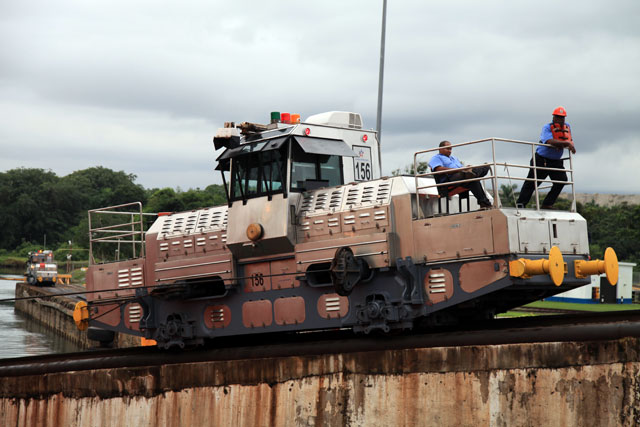|
Page 2/2 - Posted October 12, 2012
Panama Canal: An engineering marvel set in a tropical paradiseThe raising and lowering of great ships is also part of the performance in Panama. In fact, it’s the show’s most important act. It’s also the metronome whose rhythm every other performer must match. So ships rise, and ships fall; but that’s not the entire show. Ships must also move horizontally. That should be simple enough, given that they are designed for that very purpose. But this is a place where big ships maneuver in tight quarters and at slow speeds — a recipe for trouble. So others lend a hand. Some of that help comes from the pilot who knows these waters so well. More comes from the line handlers and the cables they tend. These cables run from bits on the ship’s main deck to small railroad engines called mules. Each ship is assigned four mules — two forward (one port and one starboard), and two aft (one port and one starboard) — that run on tracks laid along the canal’s edges. The mules pull the ship forward, while also providing a tension that keeps the ship centered. The ship’s propellers are turning, but that alone does not mean that the vessel is under control. There is something that mariners call bare steerage: a speed below which a rudder becomes ineffective. Moving in and out of locks requires that most vessels operate below their bare steerage speed, so the mules offer the needed stability to keep them from nudging lock walls and one another. Providing that stability means that the four mules must all play the same note at the same moment, and they do so with impressive consistency. Although the mules being used today are of a recent vintage, they seem very much at home in their role. This too is part of the canal show; the early 20th century working in perfect concert with the early 21st. Old facilities and new technologies all marking time by the lifting and lowering of great ships. The point is made anew each time a mule strains forward. The event is marked by the sharp clang of a distinctive bell on each of the little engines. The mules are new and shiny, and their engines purr in a manor consistent with contemporary technology, but the clang is of another era — essentially that of a San Francisco street car. While the movement at the locks sets the rhythm, much of the show is performed elsewhere. It’s about 51 miles from the Caribbean to the Gulf of Panama, and most of that journey is on Gatun Lake. The ship picks up speed quickly as it starts out over the lake. The pilot will remain aboard until we’ve reached the Pacific, but the line handlers make a well-rehearsed departure here. As they move from ship to launch, the Gould does not even slow down. Each line handler waits his turn, and then steps from the steel deck into the darkness. Waiting there for him is yet another launch that has no trouble slicing though the wake along our starboard side. There will be other line handlers waiting to board on the other side of the lake. In fact, they will be waiting on the other side of the continent. The Lake is big, but even in the darkness one would never mistake it for the open ocean. No mules are needed here, but lighted buoys — green to port and red to starboard if westbound — clearly delineate the deep channel’s boundary. In some spots, the lake is quite broad. In others, the shore is no more than a stone’s throw from the ship. More launches and dredges are passed, as are the many Caribbean-bound vessels. Roads, lights, and buildings dot the lake’s edge, revealing a human presence at every turn. But we also see hints that a wilderness is close at hand. There is a forest just beyond the narrow strip of mud that passes for a beach, and I had an unshakable sense of its presence. I couldn’t help but scan the lake’s edge; but is it another shiny launch that’s being sought out, or the bright plumage of a tropical bird? Either is possible. Just there, beyond the footlights that mark the water’s edge, is a jungle. It’s rich and wild, and it’s as much a part of the show as the locks or the mules or the launches. Perhaps this is one player in the show that is better seen by the light of day, but the wilderness beckons even at night. Darkness is, after all, a part of things wild. The Panama Canal is an engineering marvel set in a tropical paradise. Strange though it may sound, each complements the other quite well. Nature’s grandeur and human ingenuity seem to respect one another here. The coexistence of the two is just one more thing that commands our attention. The ship will soon be making its descent onto the largest of the Earth’s countless features, the Pacific Ocean. But for a time the crew enjoys its passage across Gatun Lake. It’s an oddity in the center of the show. Here a seagoing ship flies at 85 feet above the sea’s level, crossing a continent in a matter of hours. From the Caribbean Sea to the Gulf of Panama requires about eight such hours. The show lasts no longer than that, but memories of the performance will linger. In fact, they will remain in place long after recollections of most others shows have faded from memory. Dean Hancock is a technical editor for the U.S. Antarctic Program |



For USAP Participants |
For The Public |
For Researchers and EducatorsContact UsU.S. National Science FoundationOffice of Polar Programs Geosciences Directorate 2415 Eisenhower Avenue, Suite W7100 Alexandria, VA 22314 Sign up for the NSF Office of Polar Programs newsletter and events. Feedback Form |




